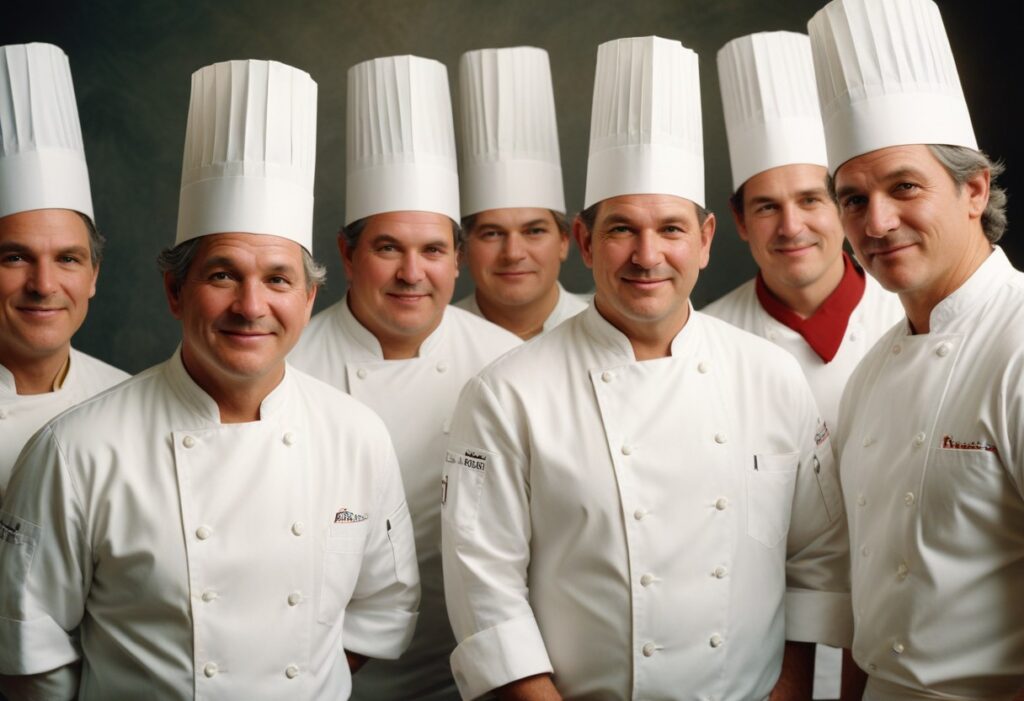Introduction
Have you ever wondered why chefs wear those tall, distinctive hats? The chef’s hat is more than just a piece of headgear; it’s a symbol of the culinary profession, steeped in history and tradition. This article dives deep into the world of the chef’s hat, exploring its origins, significance, and the various styles available today.

History of the Chef’s Hat
Origins in Ancient Times
The origins of the chef’s hat can be traced back to ancient times. It’s believed that in Assyrian times, chefs wore conical hats to distinguish themselves from other kitchen staff. These early versions were more about indicating rank and authority than the practical and symbolic purposes they serve today.
Evolution Through the Centuries
As we moved through the centuries, the chef’s hat evolved. In medieval Europe, the tall, white hat became associated with the culinary profession. By the 19th century, the toque blanche, the classic white hat we recognize today, had become the standard, largely popularized by the famous French chef Marie-Antoine Carême.

Symbolism and Meaning
Representation of Rank and Skill
The chef’s hat is not just a uniform accessory; it signifies the chef’s rank and skill level. Traditionally, the height of the hat indicated the wearer’s status in the kitchen hierarchy. The taller the hat, the higher the rank.
The Culinary Tradition
In addition to representing rank, the chef’s hat also embodies the rich traditions of the culinary arts. It’s a mark of respect for the profession and a symbol of the discipline and precision required in the kitchen.
The Design of the Chef’s Hat
Classic Toque Blanche
The most iconic design of the chef’s hat is the toque blanche. This tall, white, pleated hat is instantly recognizable and is a staple in professional kitchens around the world. Its design is both practical and symbolic, providing a way to keep hair out of food while also indicating the chef’s expertise.
Variations in Modern Designs
While the classic toque remains popular, modern chefs often wear a variety of hat styles. From skull caps to bandanas, today’s chef’s hats come in many shapes and sizes, reflecting personal style and kitchen culture.
Why Do Chefs Wear Hats?
Hygiene and Safety
One of the primary reasons chefs wear hats is for hygiene. A hat helps keep hair out of food, which is crucial in maintaining kitchen cleanliness. It also prevents sweat from dripping into dishes, ensuring that the food is safe for consumption.
Professionalism and Authority
Wearing a hat also adds to the professional appearance of chefs. It conveys a sense of authority and respect, helping to establish a chef’s presence in the kitchen. The hat is a key part of the chef’s uniform, contributing to a cohesive and professional look.
The Toque Blanche: A Closer Look
Features of the Traditional Toque
The traditional toque blanche is characterized by its tall, cylindrical shape and numerous pleats. It’s typically made from starched white fabric, giving it a crisp and clean appearance. The hat is designed to sit comfortably on the head, with an adjustable band to ensure a snug fit.
Number of Pleats and Their Significance
Legend has it that the number of pleats in a chef’s hat represents the number of ways a chef can cook an egg. While this may be more myth than fact, it highlights the hat’s role in showcasing a chef’s skills and expertise. Some toques have 100 pleats, symbolizing the mastery of the culinary arts.
Different Types of Chef’s Hats
Toque
The classic toque is the most formal and traditional type of chef’s hat. It’s typically worn by head chefs and those in leadership positions within the kitchen.
Skull Cap
A skull cap is a shorter, more practical option that is often favored by sous chefs and line cooks. It’s comfortable and easy to wear, making it a popular choice in busy kitchens.
Beret
The beret offers a more casual and stylish alternative to the traditional toque. It’s often worn in more relaxed kitchen environments and by chefs who want to express their personal style.
Bandana
Bandanas are another versatile option, offering both practicality and style. They are easy to tie and adjust, making them a popular choice for chefs who need a flexible head covering.
Materials Used in Chef’s Hats
Traditional Fabrics
Traditionally, chef’s hats were made from cotton or a cotton-polyester blend. These materials are breathable and easy to clean, making them ideal for the hot and hectic kitchen environment.
Modern Materials
Today, chef’s hats are also made from modern materials such as synthetic blends and moisture-wicking fabrics. These materials offer added comfort and durability, catering to the demands of contemporary kitchens.
How to Wear a Chef’s Hat Correctly
Proper Placement and Fit
Wearing a chef’s hat correctly is crucial for comfort and professionalism. The hat should sit squarely on the head, with the band resting just above the eyebrows. It’s important to choose a hat that fits well and can be adjusted as needed.
Tips for Comfort and Style
To ensure comfort, opt for a hat made from breathable materials and with an adjustable band. For style, consider customizing your hat with your name or a unique design that reflects your personality.
Famous Chefs and Their Iconic Hats
Julia Child
Julia Child, the beloved American chef, was often seen wearing a classic toque blanche. Her hat became a symbol of her dedication to French cuisine and her influence on American cooking.
Gordon Ramsay
Gordon Ramsay, known for his fiery personality and culinary expertise, also favors the traditional toque. His hat is a key part of his professional image, reinforcing his authority in the kitchen.
Other Notable Figures
Many other famous chefs, such as Thomas Keller and Emeril Lagasse, are known for their distinctive hats. These iconic chefs have helped to cement the hat’s place in culinary tradition.
Cultural Variations in Chef’s Hats
French Chef’s Hat
The French culinary tradition deeply roots and makes the French chef’s hat, or toque, perhaps the most recognizable. It is typically tall and white, symbolizing cleanliness and professionalism.
Italian and Other European Variations
In Italy and other European countries, chefs often wear shorter hats or caps. These variations reflect regional preferences and the diverse culinary traditions across Europe.
Asian and Other Global Styles
In Asia, chefs might wear a variety of head coverings, from bandanas to caps. Local customs and the practical needs of the kitchen environment often influence these styles.
Modern Trends in Chef’s Hats
Sustainable and Eco-Friendly Options
As sustainability becomes increasingly important, many chefs are opting for eco-friendly hats made from organic or recycled materials. These options help reduce the environmental impact of kitchen uniforms.
Custom Designs and Personalization
Customizing chef’s hats with names, logos, or unique designs is a growing trend. This personalization allows chefs to express their individuality and create a cohesive brand for their kitchen or restaurant.
The Chef’s Hat in Popular Culture
Movies and TV Shows
Chef’s hats often appear in movies and TV shows, symbolizing the culinary profession. From animated films like “Ratatouille” to cooking competitions like “MasterChef,” the hat is a key visual element that represents the world of cooking.
Advertising and Marketing
Advertisers and marketers use the chef’s hat to convey expertise and quality.Brands often use the image of a chef wearing a hat to promote food products, restaurants, and culinary services.
Buying Guide for Chef’s Hats
Key Factors to Consider
When buying a chef’s hat, consider factors such as material, fit, and style. Look for hats made from breathable fabrics, with adjustable bands for a comfortable fit. Style is also important, so choose a hat that reflects your personal taste and professional image.
Top Brands and Recommendations
Some top brands for chef’s hats include Chef Works, Bragard, and Mercer Culinary.
Professional chefs prefer these brands for their high-quality materials and durable designs.
Conclusion
The chef’s hat is more than just a piece of headgear; it’s a symbol of the culinary profession, steeped in history and tradition. From its origins in ancient times to its modern variations, the chef’s hat remains an iconic and essential part of the chef’s uniform. Whether you’re a professional chef or a home cook, understanding the significance and styles of chef’s hats can enhance your appreciation for the culinary arts.
FAQs
What is the significance of the pleats in a chef’s hat?
The pleats in a chef’s hat traditionally represent the number of ways a chef can cook an egg, symbolizing their skill and expertise.
How do I choose the right size for a chef’s hat?
To choose the right size, measure the circumference of your head and select a hat with an adjustable band to ensure a snug and comfortable fit.
Can I customize my chef’s hat?
Yes, many chefs customize their hats with names, logos, or unique designs to express their individuality and create a cohesive brand.
Are there any alternatives to the traditional chef’s hat?
Yes, alternatives include skull caps, berets, and bandanas, which offer different styles and levels of formality.
How should I care for my chef’s hat?
Care for your chef’s hat by following the manufacturer’s cleaning instructions, typically involving gentle washing and air drying to maintain its shape and appearance.
